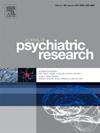The complex relationship between NSSI exposure and suicidal risk: Insights from a short-term longitudinal study
IF 3.7
2区 医学
Q1 PSYCHIATRY
引用次数: 0
Abstract
Objective
Adolescent suicide has become a critical global public health issue. While non-suicidal self-injury (NSSI) is closely associated with suicide, the role of NSSI exposure remains unclear. This study aims to explore possible mechanisms among NSSI exposure, NSSI engagement, and future suicidal risk.
Method
A total of 2,155 Chinese middle school students (47.9 % girls; M = 13.38 years, SD = 0.66) participated in the study. During the first survey, they reported demographic information, NSSI exposure, and NSSI engagement. Three months later, they completed follow-up assessments on suicidal risk and depressive symptoms.
Results
Our results revealed three distinct relational patterns between NSSI exposure, NSSI engagement, and future suicidal risk: (1) NSSI exposure is associated with future suicidal risk through the mediating role of NSSI engagement (indirect effect = 0.145, SE = 0.02, 95 % CI [0.107, 0.183]); (2) NSSI exposure independently impact suicidal risk without NSSI engagement (β = 0.046, SE = 0.018, t = 2.299, p < 0.05); (3) NSSI exposure amplifies the predictive effect of NSSI engagement (β = 0.053, SE = 0.014, t = 3.844, p < 0.001, 95 % CI [0.023, 0.010]).
Conclusions
Our findings highlight the importance of interpersonal exposure, rather than media exposure, in these pathways. This study uncovers multiple pathways through which NSSI exposure influences suicidal risk, offering preliminary evidence for targeted prevention strategies.
自伤暴露与自杀风险之间的复杂关系:来自短期纵向研究的见解
目的青少年自杀已成为一个重要的全球公共卫生问题。虽然非自杀性自伤与自杀密切相关,但自伤暴露的作用尚不清楚。本研究旨在探讨自伤暴露、自伤参与与未来自杀风险之间的可能机制。方法2155名中国中学生(女生占47.9%;M = 13.38岁,SD = 0.66)参与研究。在第一次调查中,他们报告了人口统计信息、自伤暴露和自伤参与。三个月后,他们完成了自杀风险和抑郁症状的随访评估。结果自伤暴露、自伤接触与未来自杀风险之间存在三种不同的关系模式:(1)自伤暴露通过自伤接触的中介作用与未来自杀风险相关(间接效应= 0.145,SE = 0.02, 95% CI [0.107, 0.183]);(2)无自伤接触的自伤暴露独立影响自杀风险(β = 0.046, SE = 0.018, t = 2.299, p <;0.05);(3)自伤暴露放大了自伤接触的预测效应(β = 0.053, SE = 0.014, t = 3.844, p <;0.001, 95% ci[0.023, 0.010])。我们的研究结果强调了人际接触在这些途径中的重要性,而不是媒体接触。本研究揭示了自伤暴露影响自杀风险的多种途径,为有针对性的预防策略提供了初步证据。
本文章由计算机程序翻译,如有差异,请以英文原文为准。
求助全文
约1分钟内获得全文
求助全文
来源期刊

Journal of psychiatric research
医学-精神病学
CiteScore
7.30
自引率
2.10%
发文量
622
审稿时长
130 days
期刊介绍:
Founded in 1961 to report on the latest work in psychiatry and cognate disciplines, the Journal of Psychiatric Research is dedicated to innovative and timely studies of four important areas of research:
(1) clinical studies of all disciplines relating to psychiatric illness, as well as normal human behaviour, including biochemical, physiological, genetic, environmental, social, psychological and epidemiological factors;
(2) basic studies pertaining to psychiatry in such fields as neuropsychopharmacology, neuroendocrinology, electrophysiology, genetics, experimental psychology and epidemiology;
(3) the growing application of clinical laboratory techniques in psychiatry, including imagery and spectroscopy of the brain, molecular biology and computer sciences;
 求助内容:
求助内容: 应助结果提醒方式:
应助结果提醒方式:


